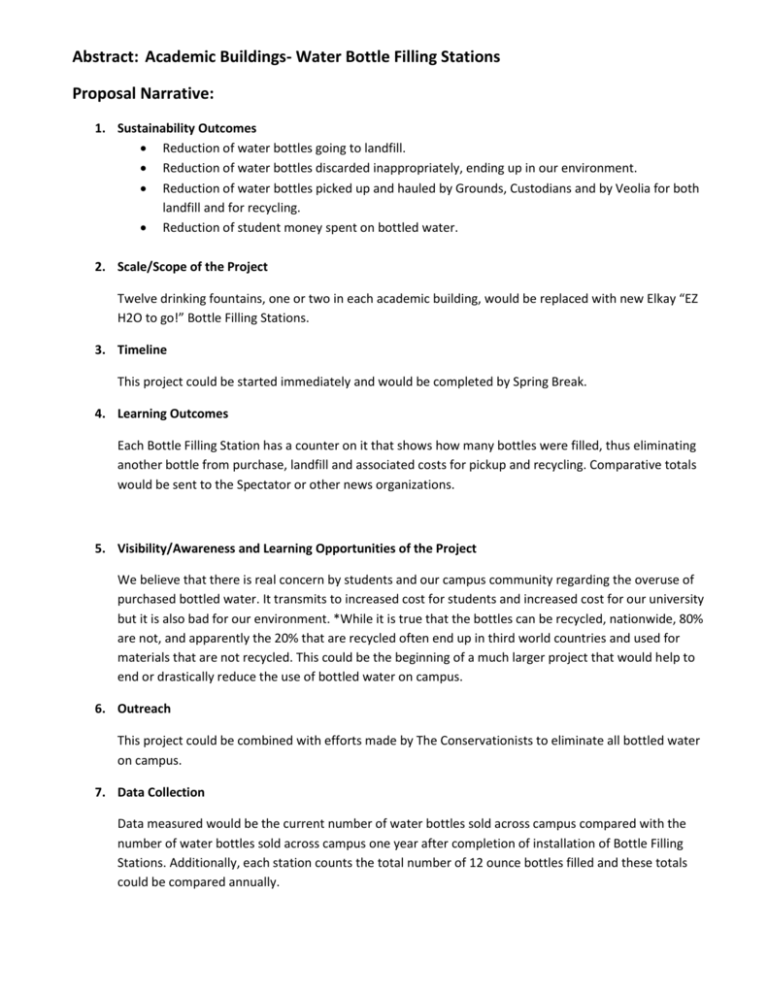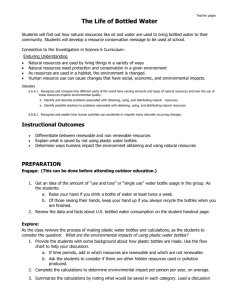Abstract: Academic Buildings- Water Bottle Filling Stations Proposal
advertisement

Abstract: Academic Buildings- Water Bottle Filling Stations Proposal Narrative: 1. Sustainability Outcomes Reduction of water bottles going to landfill. Reduction of water bottles discarded inappropriately, ending up in our environment. Reduction of water bottles picked up and hauled by Grounds, Custodians and by Veolia for both landfill and for recycling. Reduction of student money spent on bottled water. 2. Scale/Scope of the Project Twelve drinking fountains, one or two in each academic building, would be replaced with new Elkay “EZ H2O to go!” Bottle Filling Stations. 3. Timeline This project could be started immediately and would be completed by Spring Break. 4. Learning Outcomes Each Bottle Filling Station has a counter on it that shows how many bottles were filled, thus eliminating another bottle from purchase, landfill and associated costs for pickup and recycling. Comparative totals would be sent to the Spectator or other news organizations. 5. Visibility/Awareness and Learning Opportunities of the Project We believe that there is real concern by students and our campus community regarding the overuse of purchased bottled water. It transmits to increased cost for students and increased cost for our university but it is also bad for our environment. *While it is true that the bottles can be recycled, nationwide, 80% are not, and apparently the 20% that are recycled often end up in third world countries and used for materials that are not recycled. This could be the beginning of a much larger project that would help to end or drastically reduce the use of bottled water on campus. 6. Outreach This project could be combined with efforts made by The Conservationists to eliminate all bottled water on campus. 7. Data Collection Data measured would be the current number of water bottles sold across campus compared with the number of water bottles sold across campus one year after completion of installation of Bottle Filling Stations. Additionally, each station counts the total number of 12 ounce bottles filled and these totals could be compared annually. *From The Water Project website, check out Annie Leonard (“The Story of Stuff”) on “The Story of Bottled Water”. They also provide the following information. http://thewaterproject.org/bottled_water.asp?gclid=CNK45Myh5KQCFQtL5wodX2xZlA Fact #1. Bottles used to package water take over 1,000 years to bio-degrade and if incinerated, they produce toxic fumes. It is estimated that over 80% of all single-use water bottles used in the U.S. simply become "litter." Source: ValleyWater.org Fact #2. Recycling is only feasible in limited circumstances because only PET bottles can be recycled. All other bottles are discarded. Only 1 out of 5 bottles are sent to the recycle bin. Source: SunTimes Fact #3. U.S. landfills are overflowing with 2 million tons of discarded water bottles alone. Source: idswater.org Fact #4. It takes over 1.5 million barrels of oil to meet the demand of U.S. water bottle manufacturing. This amount of oil far exceeds the amount needed to power 100,000 for a year, which does not include fossil fuel and emissions costs of green house gases needed to transport the final product to market. Source: SunTimes Fact #5. It is estimated that actually 3 liters of water is used to package 1 liter of bottled water. Source: ValleyWater.org An Example: Source: http://www.treehugger.com/files/2007/02/pablo_calculate.php "In summary, the manufacture and transport of that one kilogram bottle of Fiji [brand] water consumed..." 26.88 kilograms of water (7.1 gallons) .849 Kilograms of fossil fuel (one litre or .26 gal) and Emitted 562 grams of Greenhouse Gases (1.2 pounds).








